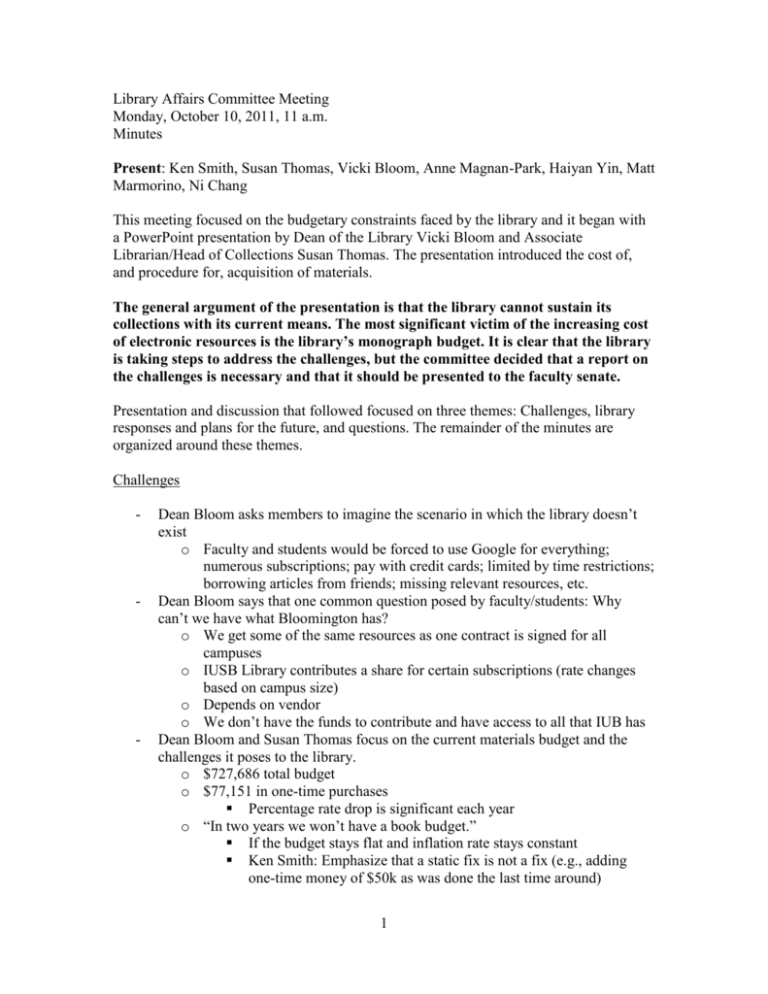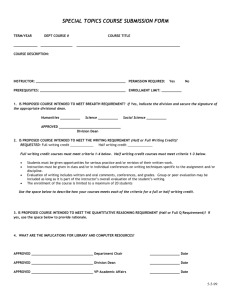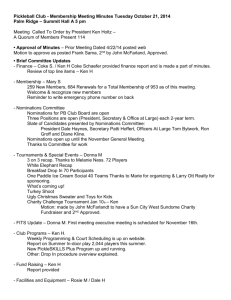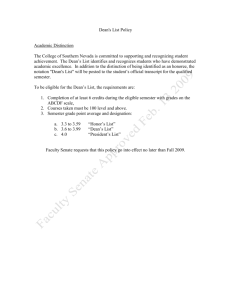October 2011
advertisement

Library Affairs Committee Meeting Monday, October 10, 2011, 11 a.m. Minutes Present: Ken Smith, Susan Thomas, Vicki Bloom, Anne Magnan-Park, Haiyan Yin, Matt Marmorino, Ni Chang This meeting focused on the budgetary constraints faced by the library and it began with a PowerPoint presentation by Dean of the Library Vicki Bloom and Associate Librarian/Head of Collections Susan Thomas. The presentation introduced the cost of, and procedure for, acquisition of materials. The general argument of the presentation is that the library cannot sustain its collections with its current means. The most significant victim of the increasing cost of electronic resources is the library’s monograph budget. It is clear that the library is taking steps to address the challenges, but the committee decided that a report on the challenges is necessary and that it should be presented to the faculty senate. Presentation and discussion that followed focused on three themes: Challenges, library responses and plans for the future, and questions. The remainder of the minutes are organized around these themes. Challenges - - - Dean Bloom asks members to imagine the scenario in which the library doesn’t exist o Faculty and students would be forced to use Google for everything; numerous subscriptions; pay with credit cards; limited by time restrictions; borrowing articles from friends; missing relevant resources, etc. Dean Bloom says that one common question posed by faculty/students: Why can’t we have what Bloomington has? o We get some of the same resources as one contract is signed for all campuses o IUSB Library contributes a share for certain subscriptions (rate changes based on campus size) o Depends on vendor o We don’t have the funds to contribute and have access to all that IUB has Dean Bloom and Susan Thomas focus on the current materials budget and the challenges it poses to the library. o $727,686 total budget o $77,151 in one-time purchases Percentage rate drop is significant each year o “In two years we won’t have a book budget.” If the budget stays flat and inflation rate stays constant Ken Smith: Emphasize that a static fix is not a fix (e.g., adding one-time money of $50k as was done the last time around) 1 - - o Continuations: $621,035 (databases, e-journals, newspapers) Electronic materials are never one-time purchases o 2010 marks last time that budget increased Increase was limited to specific databases o Serials inflation rate 7% + o Rates for electronic subscriptions have increased significantly since 2000 o Another issue arising with the serials budget and electronic resources is that certain sources are required for accreditation within programs/colleges o Book-heavy disciplines are going to suffer Arts/humanities/social sciences have the highest circulation rates o Book purchases: 2,643 (2008) to 1,490 (2010) In addition to the budget constraints, there are significant issues in the marketplace that affect the library’s purchasing power. o No competition for most items (e.g., The Chronicle) o Institutional rates are expensive o Cost for electronic editions are often higher (greater access) o It’s all or nothing on some journal packages o Formats are continually evolving o Book prices rising This is partially due to shorter print runs Message to faculty: While faculty can often turn to interlibrary loan, students typically need materials at the point and time of need. Interestingly, our collections budget compares well with our peer group; we are also third in funding among IU campuses (IUSB is the third-largest) Library responses and plans for the future - - - The Library has responded to these difficult conditions using a variety of strategies. o Seek out discounts and consortial deals with databases o Buy paperbacks o Order fewer titles (average age of collection is 1989) Matt Marmorino: What is a good average age of a collection? Seems like a flawed measure (Harvard’s collection is probably VERY old) o Making extensive cuts o Adding subject librarians o Gift books—but these are random, often times, and not targeted Dean Bloom and Susan Thomas discuss the following potential outcomes if the library budget does not see increased funding… o No department allocations in 2012 o No new journals o Cancellations of existing serial and database necessary in 2013 Ken Smith, in response to the statistics being discussed, makes a suggestion based on the last time the library committee presented such information to the Faculty Senate. At that time, the committee used an average of books per student, per 2 - - - faculty member to demonstrate the problem. Ken Smith remembers this being an effective way to communicate the issue to faculty. Extra funds are usually borrowed from the monograph budget, but soon it will all run out. o Nothing new for MS in Nursing o Nothing new for anthropology major o Ken Smith: Ten-year list of program additions with budget increases for each might be a good slide for the senate presentation Ken Smith suggests that library could set a limit for monograph budget—it cannot go below this rate. Some libraries are doing cost-per-use studies (comparing electronic resources with print subscriptions) Matt Marmorino: We need a more serious consideration of the library needs for a new program or new class. It cannot be the “check mark” system that is currently in place. People must make the effort to show that the materials are not there for the class. o Dean Bloom : Library officio was on curriculum committee at her old university o Ken Smith: Each committee should have a librarian to discuss whether or not the library has sufficient resources to support the new programs o Inspect forms for new programs/new courses; propose a re-wording of those sections. o Matt will look into the forms and send them around to the committee New courses Majors/minors Degrees/programs o All these points are made to say that that we have to stop pretending that new degrees and programs have no costs. o Could we require a base budget for new programs Could look at a program that actually did spend money on such things then set a base rate for each new program that has started in the last ten years What’s needed according to Dean Bloom and Susan Thomas: $25-50k increase every year in base budget for library materials. Questions from committee members - Ken Smith: Why is it that the monograph budget always gets cut? Why not print serials? Why not stop buying electronic subscription? o Dean Bloom says demand is for digital subscriptions o Ken Smith: Why aren’t both lines (funding for monographs and digital subscriptions) going down? Why is one going down and one going up? [We’re not treating the two budgets in the same way.] Again, demand Circulation is going down (causality issues here) Accreditation 3 - Ken Smith: How many books are owned with each year’s copyright date? This demonstrates a correlation between budget dips and the acquisition of new titles. Committee Conclusions - The committee will not develop motions for the hole that’s been dug or the inflation issue, although we should develop a report on inflation At this point committee is working toward a report that will be presented to the Faculty Senate. Future Actions of the Committee - Next meeting will focus on developing data, framing the data, and working on the rhetoric of the report Matt Marmorino will contact curriculum committee about library member and new courses/programs/majors Next meeting moved to 11:15 for November 14 4









